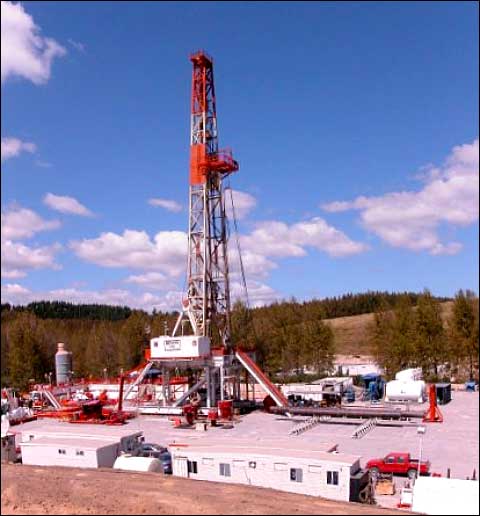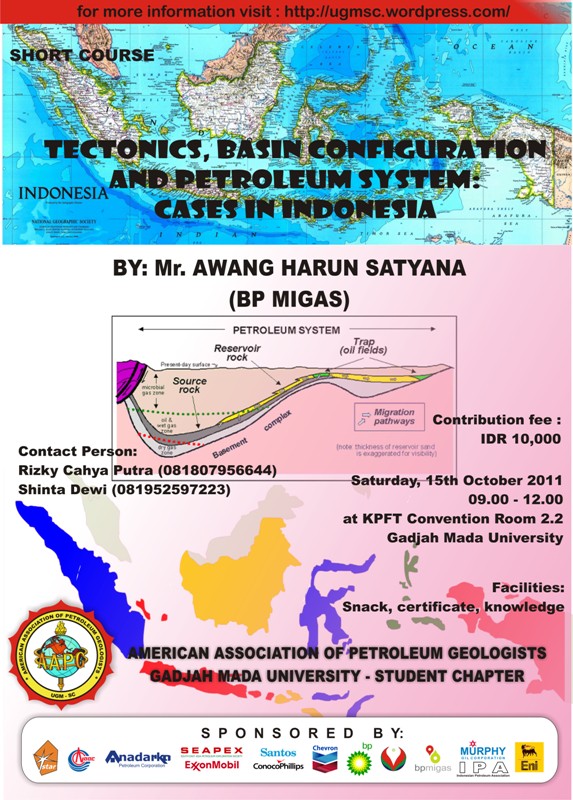http://ugmsc.wordpress.com/
Mr. Awang Harun Satyana is one of the most inspiring geologists. He is going to share his experience and knowledge in the next course of AAPG UGM-SC in theme “Tectonics, Basin Configuration, and Petroleum System: Cases in Indonesia”. And here is a short story of his journey in loving geology taken from http://aveliansyah.wordpress.com/2010/04/21/profil-awang-harun-satyana/.
Mr. Awang likes medical and geological stuffs since he was in the junior high. He’s been collecting books about those subjects since 1979, the year when he started building his own private library. Finally, he reached the number of 2.000 books as he went to senior high school.
Along 1983 – 1988, he began his journey in geological study. He went to both formal (college) and informal education (P3G). As he graduated on February 1989, he sent his applications to 40 companies. Only four of them answered : no vacancy! Then he looked for a full-time job as he part-timely worked for a mining consultant in Bandung.
In the end of 1989, there came a chance and he optimized it very well. He made it in to P3G and also Pertamina. He decided Pertamina. He occupied the position as an exploration geologist in the year of 1990-1997. In 1991, he applied for a post-graduate (S2) and a doctoral degree scholarship. From Balikpapan, he flied to Jakarta with some buddies from Pertamina to do the test. As he got back to Balikpapan, he was told that he didn’t make it because of the interview (the requirement was to love doing a research 100%, but his answer was only 50%). Was it really the criteria needed? He’s not sure, but he still love geology by the way.
Five years in the beginning of his career showed that his main job stays on the field. The geological study got further and further from him. That drove him jealous to his friends who became a part of geological studies and barely always have a chance to discuss with masters and doctors (experts), or to his friends who worked in different consultants; as he stayed in the jungle, dying to take care of the well as a well-site geologist. But one thing he always believes, is a line from Mr. Ildrem Syafri : “lebih baik menyusul diam-diam daripada membuang waktu dengan iri hati kepada orang yang berjalan di depan” (better to catch up in silence, than to waste your time in jealousy with the people walking in front of you).
Since the rejection, he fulfilled his day with studying and writing. In 1993, he sent a paper to PIT – IAGI (Annual Scientific Meeting of IAGI) or IPA; and he never stops. He keeps writing bunches of essays, papers, and articles of geology until this day, no matter what his degree is (he’s just a bachelor!-red).
He encouraged himself to keep writing even though it might be some sort of jokes for some doctors and experts. In 1997-2000, he was moved to work for a joint project between Pertamina and Santa Fe to explore the Salawati Basin. This was a priceless opportunity for him to do researches on his own. He applied the ‘learning by doing’ method. There were a lot of studies he did, including geochemistry and even structure. He did that because of his will, not from what was told by the manager. Totally, he made four reports of those studies which helped him to understand geology in a more integrated way. “No pain, no gain” was his top motto. Later in 2000, he was moved (again) to Pertamina MPS (BP Migas now). His job was to organize the activity of the petroleum contractors in Indonesia. He also had many reports from various explorations, activities, or projects, so more than a half of his publication was written in Pertamina MPAS-BP Migas.
Today, his publications has reach the number of 139 (56 papers for national and international conference, 23 articles for domestic and international journals, 6 chapters in six 6 books, 24 keynotes and speech, 24 courses in many colleges, and last but not least 9 manual books for professional courses). Those were written in the name of his love, geology; and his loyalty to the people working in geology and common people. They were the only reasons, not more, not even the money. He said that money will automatically follow us if we have the magnet to pull it. Remember that, youth!


